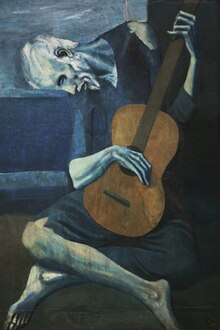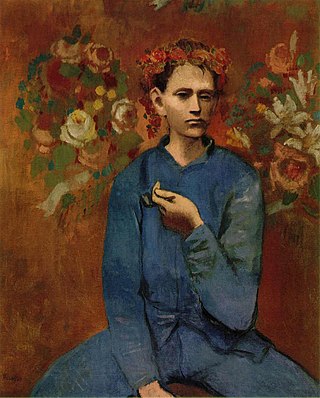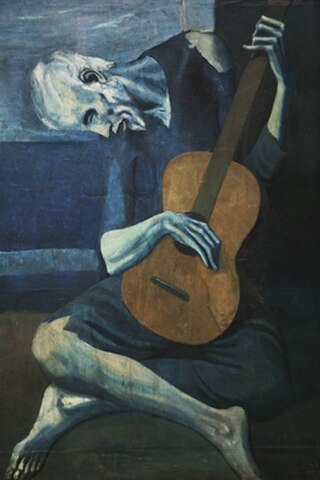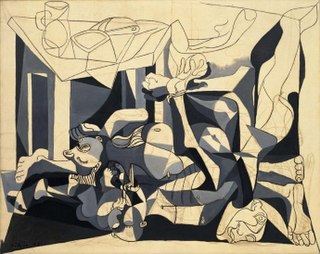
The Man With the Blue Guitar is a poem published in 1937 by Wallace Stevens. It is divided into thirty-three brief sections, or cantos.

The Man With the Blue Guitar is a poem published in 1937 by Wallace Stevens. It is divided into thirty-three brief sections, or cantos.
The poem has been discussed as taking the form of an imaginary conversation with the subject of Pablo Picasso's 1903-04 painting The Old Guitarist , which Stevens may have viewed when it was exhibited at the Wadsworth Atheneum in Hartford, Connecticut, in 1934. But Stevens insisted this influence was only peripheral. In a letter dated July 1, 1953, to Professor Renato Poggioli, who had recently translated his poem into Italian, Stevens wrote: "I had no particular painting of Picasso's in mind and even though it might help to sell the book to have one of his paintings on the cover, I don't think we ought to reproduce anything of Picasso's." [1]
Paul Mariani, a biographer of Stevens, presented a counterpoint to these objections raised by Stevens concerning the origin of this poem stating, "Despite his repeatedly denying it, Stevens does seem to have a particular painting in mind here: Picasso's 1903 The Old Guitarist, which portrays an old man with white hair and beard sitting distorted and cross-legged as he plays his guitar. If Picasso attempted to portray the world of poverty and abject misery, it was because that had been his own plight as a struggling young artist in Barcelona, where he painted many pictures including this one, of the poor. The painting is almost entirely done in monochromatic blues and blue-blacks, except for the guitar itself, which is painted in a slightly warmer brown. The man is blind but, no longer seeing the world around him, he sees more deeply into the reality within." [2]
In the poem, an unnamed "they" says, of the titular man, "you do not play things as they are", sparking a prolonged meditation on the nature of art, performance, and imagination. [3]
Stevens began writing the poem in December 1936, not long after his completion of the poetry collection Owl's Clover in the spring of that year. [4] The Man With the Blue Guitar became one of his most successful long poems, [4] and William Carlos Williams wrote at the time that he considered it one of Stevens's best works. [5]
Michael Tippett based his guitar sonata, The Blue Guitar (1984), on selected stanzas: 19, 30, and 31, from the poem, [6] and John Banville's 2015 novel The Blue Guitar draws its title and epigraph from the poem.
Dean Koontz uses lines from the poem as a password in his 2017 book The Silent Corner.
David Hockney created a suite of twenty etchings entitled The Blue Guitar (1976–1977). The frontispiece mentions Hockney's dual inspiration as "The Blue Guitar, Etchings by David Hockney who was inspired by Wallace Stevens who was inspired by Pablo Picasso".

Pablo Ruiz Picasso was a Spanish painter, sculptor, printmaker, ceramicist and theatre designer who spent most of his adult life in France. One of the most influential artists of the 20th century, he is known for co-founding the Cubist movement, the invention of constructed sculpture, the co-invention of collage, and for the wide variety of styles that he helped develop and explore. Among his most famous works are the proto-Cubist Les Demoiselles d'Avignon (1907), and the anti-war painting Guernica (1937), a dramatic portrayal of the bombing of Guernica by German and Italian air forces during the Spanish Civil War.

Wallace Stevens was an American modernist poet. He was born in Reading, Pennsylvania, educated at Harvard and then New York Law School, and spent most of his life working as an executive for an insurance company in Hartford, Connecticut. He won the Pulitzer Prize for Poetry for his Collected Poems in 1955.

David Hockney is an English painter, draftsman, printmaker, stage designer, and photographer. As an important contributor to the pop art movement of the 1960s, he is considered one of the most influential British artists of the 20th century.

Garçon à la Pipe is an oil on canvas painting by Pablo Picasso. It was painted in 1905 when Picasso was 24 years old, during his Rose Period, soon after he settled in the Montmartre area of Paris. The painting depicts a Parisian adolescent boy who holds a pipe in his left hand and wears a garland of flowers on his head, surrounded by two floral decorations. The subject was a local boy named "P’tit Louis" who died at a young age. The painting is listed as one of the most expensive paintings, after being sold at Sotheby's auction for $104 million on 5 May 2004. It is currently the fifth highest selling painting by Picasso.

The Blue Period is a term used to define the works produced by Spanish painter Pablo Picasso between 1901 and 1904 when he painted essentially monochromatic paintings in shades of blue and blue-green, only occasionally warmed by other colors. These somber works, inspired by Spain and painted in Barcelona and Paris, are now some of his most popular works, although he had difficulty selling them at the time.

The Old Guitarist is an oil painting by Pablo Picasso, which he created in late 1903 and early 1904. It depicts an elderly musician, a haggard man with threadbare clothing, who is hunched over his guitar while playing in the streets of Barcelona, Spain. It is on display at the Art Institute of Chicago as part of the Helen Birch Bartlett Memorial Collection.
"Metaphors of a Magnifico" is a poem from Wallace Stevens's first book of poetry, Harmonium (1923). It was first published in 1918, so it is in the public domain. The poem experiments with perspective.

The Weeping Woman is a series of oil on canvas paintings by Pablo Picasso, the last of which was created in late 1937. The paintings depict Dora Maar, Picasso's mistress and muse. The Weeping Woman paintings were produced by Picasso in response to the bombing of Guernica in the Spanish Civil War and are closely associated with the iconography in his painting Guernica. Picasso was intrigued with the subject of the weeping woman, and revisited the theme numerous times that year. The last version, created on 26 October 1937, was the most elaborate of the series, and has been housed in the collection of the Tate Modern in London since 1987. Another Weeping Woman painting is housed at the National Gallery of Victoria and was involved in a high-profile political art theft.

The Dream and Lie of Franco is a series of two sheets of prints, comprising 18 individual images, and an accompanying prose poem, by Pablo Picasso produced in 1937. The sheets each contain nine images arranged in a 3x3 grid. The first 14, in etching and aquatint, are dated 8 January 1937. The remaining four images were added to the second printing plate later, without use of aquatint, and dated June 7, 1937.

The Swing, also known as The Happy Accidents of the Swing, is an 18th-century oil painting by Jean-Honoré Fragonard in the Wallace Collection in London. It is considered to be one of the masterpieces of the Rococo era, and is Fragonard's best-known work.

Aldo Crommelynck was a Belgian master printmaker who made intaglio prints in collaboration with many important European and American artists of the 20th century. At the time of his death, The Guardian termed Crommelynck the 'pre-eminent' and 'the most celebrated printmaker of the second half of the 20th century.'

The Actor is an oil on canvas painting by Spanish painter Pablo Picasso, created from 1904 to 1905. The painting dates from the artist's Rose Period. It is housed in the collection of the Metropolitan Museum of Art in New York City.

The Charnel House is a 1944–1945 oil and charcoal on canvas painting by Spanish artist Pablo Picasso, which is purported to deal with the Nazi genocide of the Holocaust. The black and white 'grisaille' composition centres on a massed pile of corpses and was based primarily upon film and photographs of a slaughtered family during the Spanish Civil War. It is considered to be Picasso's second major anti-war painting, the first being the monumental Guernica (1937), although it is smaller than its predecessor and unfinished. The painting is housed in the Museum of Modern Art in New York City.
Picasso's written works, that is, works created by Pablo Picasso, are often overlooked in discussion of his long and varied career in the mediums of painting, sculpture, drawing, collage, papier-mâché, (photography), assemblage, ready-mades, printing, ceramics and theatre designs. Despite being immersed in the literary sphere for many years, Picasso did not produce any writing himself until the age of 53. In 1935 he ceased painting, drawing and sculpting, and committed himself to the art of poetry; which in turn was briefly abandoned to focus upon singing. Although he soon resumed work in his previous fields, Picasso continued in his literary endeavours and wrote hundreds of poems, concluding with The Burial of the Count of Orgaz in 1959.

La Vie is a 1903 oil painting by Pablo Picasso. It is widely regarded as the pinnacle of Picasso's Blue Period.

The Blue Room is a 1901 oil on canvas painting by Pablo Picasso, which he painted during his Blue Period. It depicts a scene of a nude woman bending over in a bath tub. A hidden painting was revealed beneath the surface by x-ray images and infra-red scans, showing a portrait of a bearded man. The painting has been housed in The Phillips Collection, in Washington D.C. since 1927.

The Blue Guitar is a suite of twenty etchings with aquatint by David Hockney, drawn in 1976–77 and published in 1977 in London and New York by Petersburg Press.
Woman Ironing is a 1904 oil painting by Pablo Picasso that was completed during the artist's Blue Period (1901—1904). This evocative image, painted in neutral tones of blue and gray, depicts an emaciated woman with hollowed eyes, sunken cheeks, and bent form, as she presses down on an iron with all her will. A recurrent subject matter for Picasso during this time is the desolation of social outsiders. This painting, as the rest of his works of the Blue Period, is inspired by his life in Spain but was painted in Paris.

Famille d'acrobates avec singe is a 1905 painting by Pablo Picasso. It depicts a family of travelling circus performers during an intimate moment. The work was produced on cardboard using mixed media: gouache, watercolour, pastel and Indian ink. It is held by the Gothenburg Museum of Art in Gothenburg, Sweden. The work was painted at a key phase in Picasso's life, as he made the transition from an impoverished bohemian at the start of 1905 to a successful artist by the end of 1906.
The Blue Guitar is a 1977 suite of twenty etchings with aquatint by David Hockney.